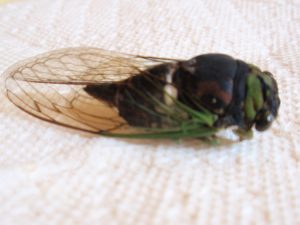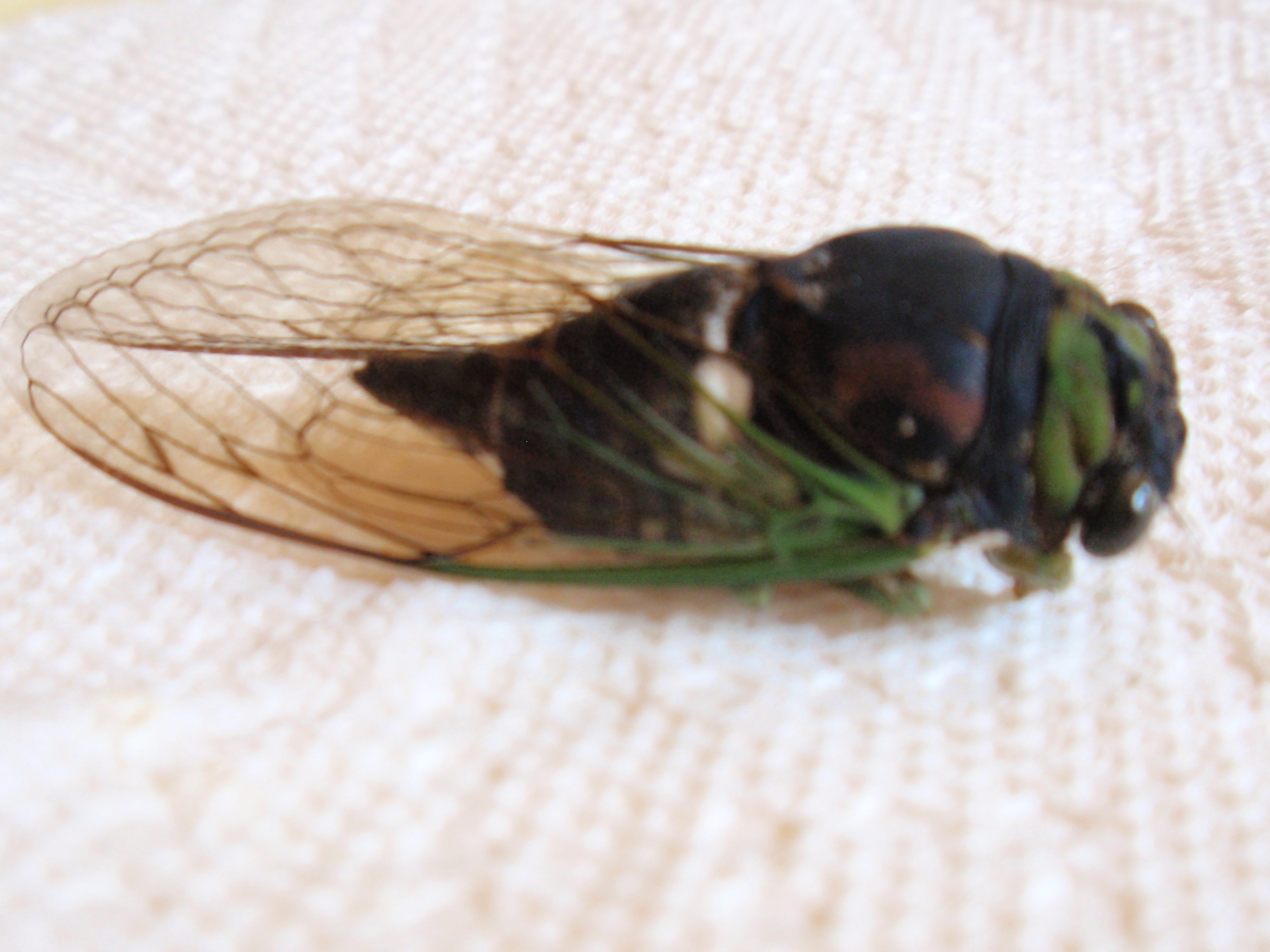
Once I realized that multiple species used my tiny backyard, I became obsessed with know which was which. There are only a limited number of local species I needed to learn and I know hundreds of bird songs. This should have been easy. No, I spend hours and hours listening to audio clips and sorting through guides searching for clues. With this blog, I attempt to condense all my work into something you can use in hopes that you will be able to step outside your house and quickly derive as much enjoyment as I do from knowing.
Therefore, this is more a reference blog than an experiential blog, though it can become experiential for you. I would love to hear from people who actually used any of this information. Do remember, there are other genera of cicadas, but the Neotibicens are loud and most often call from deciduous trees in the east. The farther you go west, the more you will find other genera. My friends in Texas and Nebraska have a whole bunch of genera to deal with.
For me, the summer sounds are much more thrilling when I can hang a name on the sound.
Below is the list of cicadas in the genus Neotibicen and the states that Bugguide has images from. I always love Bugguides cautionary statement: “The information below is based on images submitted and identified by contributors. Range and date information may be incomplete, overinclusive, or just plain wrong.” Gotta love their honesty. So to start learning your Neotibicens find your state and focus on just those species. I marked Pennsylvania with an asterisks, as they were the ones I started with. The common names are also from bugguide. The common names are not official names but colloquial names that some people may remember better.
- Dog-day cicada – Neotibicen canicularis* – Manitoba east to the coast in Canada, ME, NH, VT, MA, RI, CT, NY, NJ, PA, OH, MI, IN, IL, WI, MN, IO, ND
- Linne’s cicada – N. linnei* – ONT. NY, NJ, PA, DE, MD, VA, WV, NC, SC, GA, FL, AL, TN, KY, OH, IN, MI, WI, IO, NE
- Scissor grinder – N. pruinosus – WV, OH, IN, IL, IO, SD, NE, KS, OK, TX, LA, AR, MO, KY, TN, MS, AL
- Eastern scissor grinder – N. winnemanna*- PA, MD, VA, NC, SC, TN
- Coastal scissor grinder – N. latifasciatus – DE, MD, NC, FL (I suspect there are significant gaps in this species data.)
- Robinson’s annual cicada – N. robinsonianus – ONT, VA, NC, SC, KY, TN, AL, IN, IL, IO, MO, OK, TX
- Lyric cicada – N. lyricen* – MA, CT, RI, NY, NJ, PA, DE, MD, VA, WV, NC, SC, GA, FL, AL, MS, TN, KT, OH, MI, IN, IL, WI, IO, MO, NE, KS, AR, LA, OK, TX
- Swamp cicada (someday I may rant about why I think this is a bad choice) – N. tibicen* – ONT, CT, NY, NJ, PA, DE, MD, VA, WV, NC, SC, GA, FL, AL, MS, TN, KT, OH, IN, IL, MO, KS, AR, LA, OK, TX
- Similar Dog-day cicada – N. similaris – FL, GA, AL
- Superb dog-day cicada – N. superbus – OK, AR, TX
- Davis’s southeastern dog-day cicada – N. davisi – MD, VA, NC, SC, GA, FL, AL, MS, AR, TN
- Plains dog-day cicada – N. auriferous – NE, KS, MO, OK, TX
- Northern dusk singing cicada – Megatibicen auletes is a species found in PA and loud, so I am adding that in, though I have not heard one locally.
I eventually found what I think is the best web site for sounds: http://www.insectsingers.com/100th_meridian_cicadas/index.html.The problem is they never completed the web site to include pictures of the insects and maps. How I wish someone would finish the work! They do give a decent description of the habitat where each species is apt to be found. I strongly recommend you open that web site before you proceed, it is a real ear opener. Here are the species for my yard in order of abundance.
- N. winnemanna – Eastern Scissor(s) Grinder – Starts with a single note, quickly becomes a slow pulse (weeo, weeo, weeo …) building in volume and speed before tailing off and stopping. The song lasts about 20 seconds, and is usually heard in the evening.
Along the coast one might hear N. latifasciatus calling from cedar trees with an almost identical song, but rarely heard in the evening. West of the Appalachian Mountains, this species is replaced by N. pruinosus which sounds almost identical. Location, Location, Location.
- N. tibicen – Swamp Cicada – A slow build to a rapid high pitched pulse before tailing off—zeeeeeeededededededededededezeeeee—the sound last for less than 10 seconds.
Generally it is heard early in the day low in the deciduous tree. There are long pauses between each song.
- N. linnei – Linne’s Cicada – Sounds like the swamp cicada but the song is longer running generally more than 10 seconds and less than 30 seconds long.
Usually heard earlier in the day high in deciduous trees.
- N. lyricen – Lyric Cicada – This has a long droning song 30 seconds or more, described as syrupy and the volume also pulses.
Calls from high in deciduous trees.
The Dog-day cicada (N. canicularis) is found in Pennsylvania but not in my yard. It has a high pitched whine that reminds me of a circular saw cutting wood. The sound comes from evergreens usually. I identified my first one driving down the highway in Connecticut at 55 miles an hour. (Hmm. Are there any highways in Connecticut where I or anyone else actually drives as slow as 55?) N. canicularis sounds similar to N. davisi and N. auriferous, but once again, pay attention to the locations.
Once on a trip to Virginia, we stopped at a hotel and I heard a very distinctive cicada which sounded like someone twirling one of those New Year’s spinners very slowly and rhythmically at one revolution per second. Thankfully, I had my laptop and I quickly did a search and discovered my first N. robinsonianus. It is a sound I will not forget!
I added a Megatibicen to my description list because Megatibicen auletes fits the description of loud and singing from deciduous trees and possibly in Pennsylvania, though is it more common farther south. Here is a quote from bugguide as to the sound.
“The call might best be described as follows:…There is a “winding up phase”…. rrrrrrrrrrrrrrrrrr … followed by a “Dirrrrrrrrrrr….Dirrrrrrrr…Dirrr-Dirrr-Dirrr-Dirrr-Dirrr-..etc. before winding down with an often prolonged croaky Dirrrrrrrr…rrrrr..rrrrr….”
All of the song recording are from my yard and I made the identification, but I have not verified my identification with any experts.
Since discovering cicadas, I find great enjoyment in their sound and in knowing I can identify them. I still need to hear six Neotibicen species and lots of other genera, but my ears await the new sounds. When I am traveling over the next couple months, I will be taking my audio recorder with me to capture as many sounds as I can! In the evenings, I will play them on the program Audacity so I can see the sounds also and can edit out background noise. This is going to be fun!
I will spare you any more information about cicadas for a year-maybe. I promise I will try to include more experiential blogs in the near future.
Here is my challenge to you. This is the time of the year to explore the dog-day or annual cicadas. Out west and down south, there are other genera and species to contend with, but with the resources I have provided, I hope you can get to know your local cicadas. Get outside and listen!
Down on the bottom banner of the website, you can find a link to follow my blogs. Just chose how you want to be notified by clicking the proper button or buttons. That way you won’t miss any. Once again, I love comments (praise and constructive criticism) and likes.
Resources:
- http://www.insectsingers.com/100th_meridian_cicadas/index.html – A good source for the cicada sounds, wish someone would add the maps and pictures.
- http://bugguide.net/node/view/166306/bgpage?from=0 – This will get you to the top page in bugguide for all the US cicada genera. I used this site to figure out which insect could be seen in which state.
- http://www.cicadamania.com/genera/north-america.php – This site has lots of information about a lot of different species, but is not complete It can be a huge help in sorting out cicadas in your area and is especially helpful if you have one in your hand.


Bob, I missed my window of opportunity this year to study the sounds of the cicada. The only one that I know is in my neighborhood is the swamp cicada. I never listened with a discerning ear before. It will be on my list of fun things to do in 2018. Thank you.